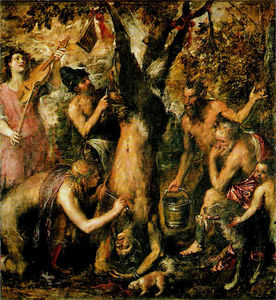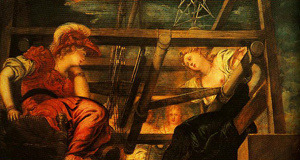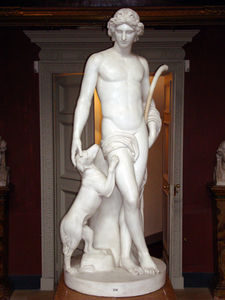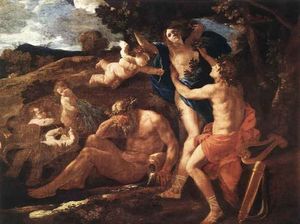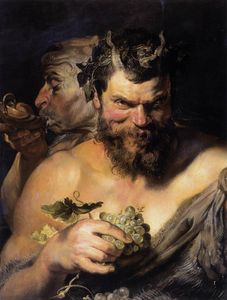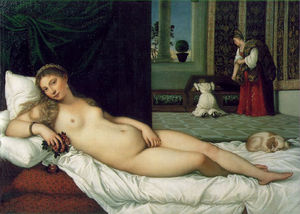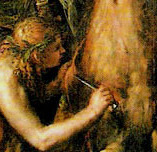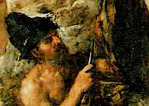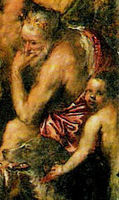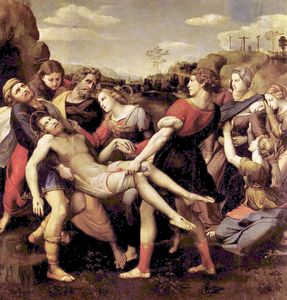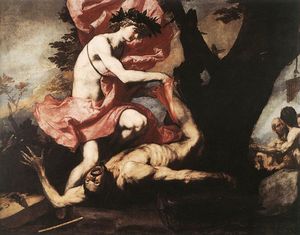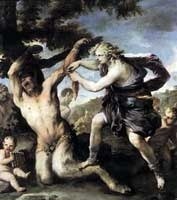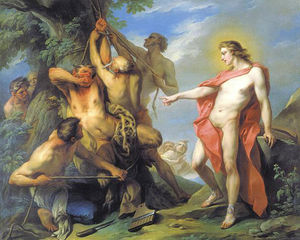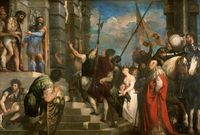The Flaying of Marsyas
- Date of Creation:
- 1576
- Height (cm):
- 212.00
- Length (cm):
- 207.00
- Medium:
- Oil
- Support:
- Canvas
- Subject:
- Figure
- Art Movement:
- Renaissance
- Created by:
- Titian
- The Flaying of Marsyas Page's Content
- Story / Theme
- Inspirations for the Work
- Analysis
- Critical Reception
- Related Paintings
- Locations Through Time - Notable Sales
- Artist
- Art Period
- Bibliography
The Flaying of Marsyas Story / Theme
In Greek mythology Marsyas was a satyr - a being that was half-man and half-goat - who was renowned for his flute playing.
According to legend, the goddess Athena invented a flute, made of Deer bone. She was proud of her new invention and performed for the other gods at a banquet on Mt. Olympus.
Upon seeing Athena's cheeks puff out in an unsightly manner from blowing air through the flute, the other goddesses laughed at her. Athena, bewildered, went to the forest and began to play along a stream where she was able to catch a glimpse of her reflection. The sight of her rotund and puffing cheeks was not very goddess-like, as the others had cruelly pointed out, and she threw the instrument away in disgust. The curious satyr, Marsyas, passed by and picked it up.
His musical skills were almost instant - bolstered, some say, by the last traces of the goddess's breath that were still lingering in the instrument.
Regardless of where his ability originated, Marsyas spent many hours filling the forest with what were probably some of the purest and most sprightly musical notes ever heard. But, as many other fine figures from Greek mythology had done, Marsyas fell into the trap of hubris.
He developed an ego about his flute skills and challenged the god Apollo to a contest. Apollo was a well-rounded Greek and Roman god linked (at the very least) to the sun, light, archery, medicine, prophecy and the arts.
Some say that it was actually Apollo who challenged Marsyas, fearing that the satyr's skills had indeed surpassed his own, and planning a cunning trick to thwart this potential musical revolution.
Either way, the challenge was set, with the stipulation that the winner would get the privilege to choose to do whatever he wanted to the loser.
With the Muses as judges, the two musicians began to play - Marsyas on his flute and Apollo on his lyre. After one round of all-round tonal perfection, intricate fingerings and captivating melodies, the contest was a draw. The Muses could not decide on a winner, so Apollo suggested that they sing while playing, so that their musicianship may be judged on both their instrument and voice.
When Marsyas protested, saying that it was impossible for him to play the flute and sing simultaneously, Apollo retorted that blowing into the flute is practically the same thing as singing.
The Muses judged Apollo's logic to be correct and since Marsyas could not compete with Apollo's sweet singing and concurrent lyre-playing, he lost.
As his prize, Apollo demanded that Marsyas be flayed alive. Acting as executioner himself, Apollo is said to have hung Marsyas from a pine tree where he torturously removed the doomed satyr's skin.
The whole forest, including gods and goddesses, mourned the loss of Marsyas and the cruelty of his punishment. Their tears are said to have created the river Marsyas in Phrygia.
The Flaying of Marsyas Inspirations for the Work
Titian's The Flaying of Marsyas was actually a more recently studied painting, having been rediscovered, so to say, in 1924. No evidence exists that this was a commissioned work, rather, scholars believe that at this stage in his life and career, Titian had turned over the bulk of his commissioned work to members of his workshop.
Towards the end of his life, it is widely believed that Titian occupied his time with serious contemplation, painting subjects of his own choosing as a kind of therapy for helping him to achieve a deeper understanding his life and the world around him.
He is believed to have reveled in the freedom to choose his own themes and most of his signed paintings from the last years were not commissioned.
Greek & Roman mythology:
Perhaps from habit after years of poring over Ovid's Metamorphoses to complete the poesie for Philip II of Spain, Titian once again delivered a work based on classical mythology. Titian was possibly inspired by this emotional plea made by Marsyas in Ovid's poem, in which the satyr says, "Why do you tear me from myself? Oh, I repent! Oh, a flute is not worth such a price!"
Scenes from mythology were popular throughout Titian's life, largely in part to the Renaissance ideals of returning to Classicism in order to move forward.
Often, scenes from mythology were used to parallel an ideal or aspiration, as with Philip II's poesie, which contained hugely erotic and power-driven overtones.
The Flaying of Marsyas Analysis
This powerful painting has been studied through the lens of iconic themes of the Catholic tradition such as sacrifice, the struggle between good and evil, original sin and the last judgment seeping from beneath the surface mythology.
Brushstroke:
Perhaps the most salient feature of The Flaying of Marsyas and what differentiates it from Titian's earlier works, is the fiery and violent brushstrokes.
These chaotic strokes of dark reds, yellows and browns don't define the forms clearly, but rather evoke them and their energies - giving the viewer an emotional impression of the horrendously brutal punishment that is taking place on the canvas before them.
This level of roughness could have easily been perceived as grotesque by people during the Renaissance - the style of brushwork Titian employed in The Flaying of Marsyas was unusual and not commonly seen in the works of other artists until more recent times, particularly during the Impressionist era.
Impasto:
Closely related to his vibrant brushstrokes is Titian's use of impasto, a painting technique that involves layering the paint on thickly, giving the image a more three-dimensional quality.
In Italian, the word "impasto" means "mixture" or can be linked to the verb "impastare" meaning "to knead. " This nomenclature makes sense since artists like Titian would have often mixed the paint right on the canvas, while almost molding it to match their artistic vision.
Mood, tone and energy:
Thanks largely to Titian's bold brushstrokes and impasto technique, his depiction of The Flaying of Marsyas is one that exudes dramatic energy as well as various emotional moods.
The chaotic scene is swimming with limbs and gestures, creating a mishmash of activity surrounding the central action of the inverted Marsyas receiving his punishment.
No figure seems particularly pleased to be participating in this execution - perhaps with the exception of Pan, holding the pail and offering a helping hand. In fact, some of the faces hint at a deep remorse and sadness.
The man seated next to Pan is King Midas, of the golden touch, who seems lost in contemplation, observing this harsh treatment with a poignant silence. Many scholars believe that Midas is also a self-portrait that Titian wove into this scene.
Subjects:
Marsyas isn't the only significant figure in this image - Titian chose to make each of the subjects important in adding some layer of this story and depiction. Naturally, Marsyas himself, upside-down and tied to a tree, occupies the center of the painting.
It isn't clear who the androgynous figure working on his chest is (some believe it to be Apollo, while others suspect it is one of Apollo's followers), or who the male figure removing the skin from Marsyas' legs is. But the seriousness with which they perform their task shows that they are probably ill-at-ease with the proceedings.
The cap worn by the standing figure - a Phrygian cap - is remarkably similar to the corno, the traditional head covering of the Doge's of Venice. It's possible Titian used this to subtly symbolize the establishment's attitude toward performing duties.
The demonic figure eagerly offering forth the wooden pail is believed to be Pan, another satyr, and the god of shepherds and theatrical criticism who is also a famous musician, championing the pan-pipes, which were named for him.
Slightly below Pan is King Midas, who had the gift of the golden touch. Midas is in deep contemplation and is sporting new goat ears, courtesy of Apollo who, according to some versions of the myth, affixed them when the king cast his vote for Marsyas instead of the god.
Below King Midas is the only figure in the painting meeting the eye of the viewers - a small child, possibly a young satyr. He is restraining a dog and engaging the viewers, almost challenging them to make sense of these chaotic events.
Finally, the figure on the far left playing the violin or fiddle is believed to be Apollo himself, overseeing Marsyas' punishment and possibly gloating by continuing to force the doomed satyr to hear the god's music until the moment of his death.
The Flaying of Marsyas Critical Reception
During life:
Well-respected Italian art critic, Lodovico Dolce, was a huge proponent of the colorful, sensuous Venetian style of painting. He appreciated Titian and other artists like him so much that he often favored them over the rival Florentine school, a move that was later viewed by some as art critic suicide.
According to Dolce, artists such as Michelangelo and Raphael of the Florentine art movement who attempted to perfectly replicate the human form often succeeded only "in making the human figure look flayed or shriveled up or ugly. "
Artists such as Titian, however, went about their work "in a delicate manner," so as to "give an indication of the bones where he needs to do so, but he covers them smoothly with flesh and fills the nude with grace," such as he rendered The Flaying of Marsyas. (Jacobs)
After death:
Housed in relative obscurity in a gallery in the Czech Republic, The Flaying of Marsyas was nearly forgotten by art historians and critics until it was rediscovered, so to say, in 1924. Since then, knowledge about its history has only increased slightly.
Yet, while research might be somewhat delayed, admiration for the work is by no means following the same path. Critics consider The Flaying of Marsyas to be an excellent example of Titian's later work, where he chose to employ a much more liberal approach to painting. This artwork has been described as truly sublime, haunting and visionary.
The Flaying of Marsyas Related Paintings
The Flaying of Marsyas Locations Through Time - Notable Sales
The Flaying of Marsyas was in the collection of the Earl of Arundel starting in the 17th century. Rumor has it that Arundel dispatched one of his aides to Venice to purchase a rare Titian painting to match his rival, the Duke of Buckingham, who had purchased Titian's Ecce Homo at a price much lower than what Arundel offered.
After the Earl's death, the painting shifted hands numerous times, in sales and acquisitions throughout Europe that were not well-documented.
Today, The Flaying of Marsyas is on display at the unassuming Muzeum Kroměřížska, or the Kromeriz State Museum in Kromeriz, Czech Republic.
The Flaying of Marsyas Artist
-

Mary Magdalen, Titian
When Titian completed The Flaying of Marsyas, he was a very old man, in his 70s or 80s. While some scholars speculate that perhaps failing vision or lack of time led Titian to produce more free-form works such as this, it is likely that he purposefully chose to paint in this style as an expression of his ever-expanding repertoire and additional freedom.
Born around 1490, Titian was apprenticed to the renowned Giovanni Bellini and quickly began to produce his own well-executed and memorable pieces.
He is credited with firmly establishing and championing the Venetian style of painting, first introduced by his teacher.
The Flaying of Marsyas Art Period
While at first glance The Flaying of Marsyas might appear as if it belongs in the same Impressionistic category as Monet's Lily Pond painting, Titian painted this, and indeed all of his works, during the High Renaissance in Italy.
During his career, Titian was dragged into an ideological battle between his Venetian school of art and the somewhat more established Florentine school, championed by the likes of Michelangelo and Raphael.
While the painters of Venetian school during the Renaissance preferred luminous, sensuous colors, the Florentine painters were much more focused on executing exact form and well-drawn figures.
Although it's nearly impossible for the untrained eye to spot any significant difference (since all the Renaissance masterpieces, regardless of style, are considered wonders), various Florentine painters made jabs at those of the Venetian school for not understanding basic drawing techniques.
The Flaying of Marsyas Bibliography
For further reading on Titian, please choose from the following recommended sources.
• Biadene, Susanna. Titian: Prince Of Painters. Marsilio Editori, 1990
• Bowron, Edgar Peters. Titian and the Golden Age of Venetian Painting (Museum of Fine Arts, Houston). Yale University Press, 2010
• Hudson, Mark. Titian: The Last Days. Bloomsbury Publishing, 2009
• Humfrey, Peter. Titian. Phaidon Press Ltd, 2007
• Ilchman, Frederick, et al. Titian, Tintoretto, Veronese: Rivals in Renaissance Venice. Lund Humphries, 2009
• Pagden, Sylvia Ferino & Scire, Giovanna Nepi. Later Titian and the Sensuality of Painting. Marsilio,Italy, 2008

